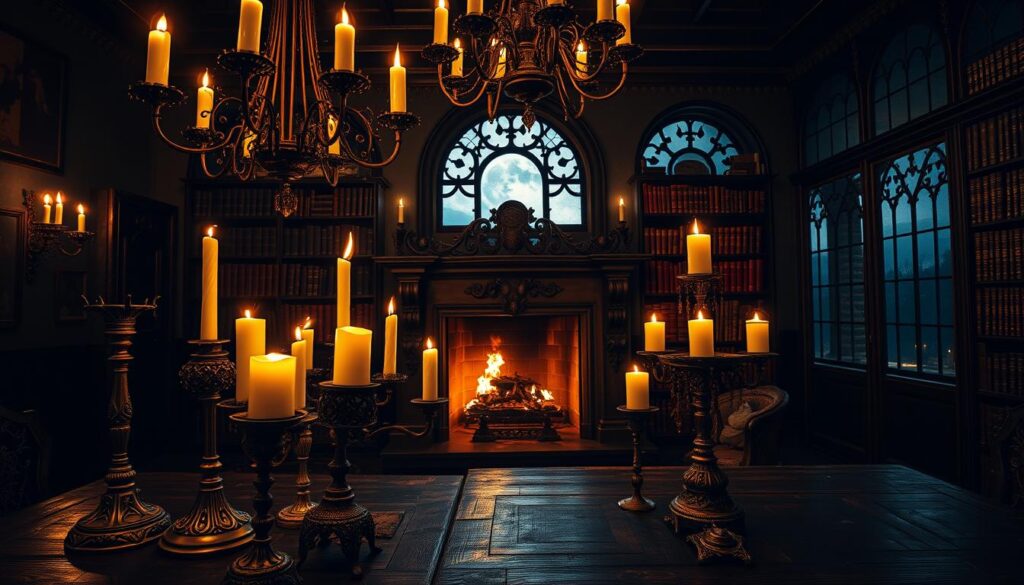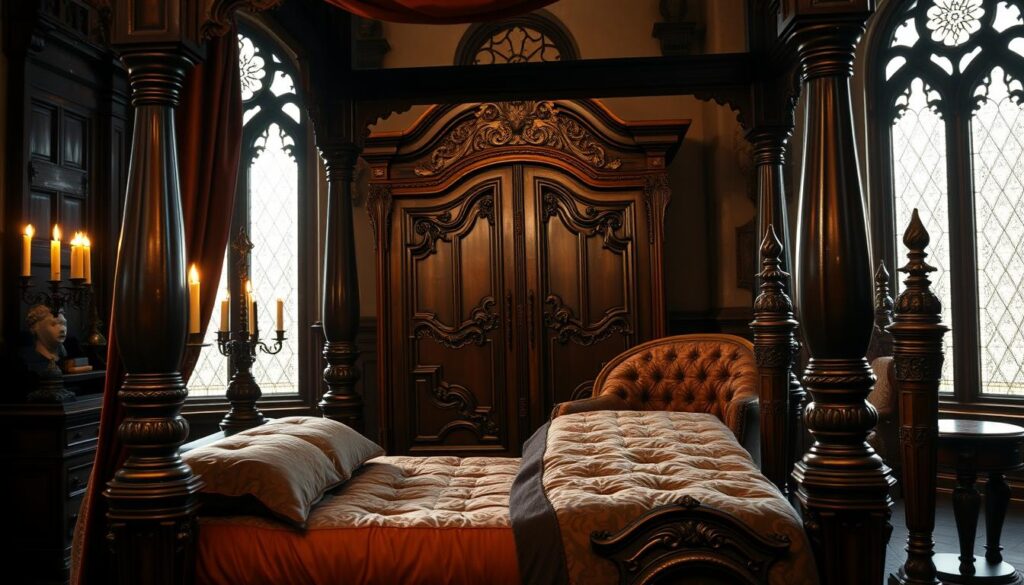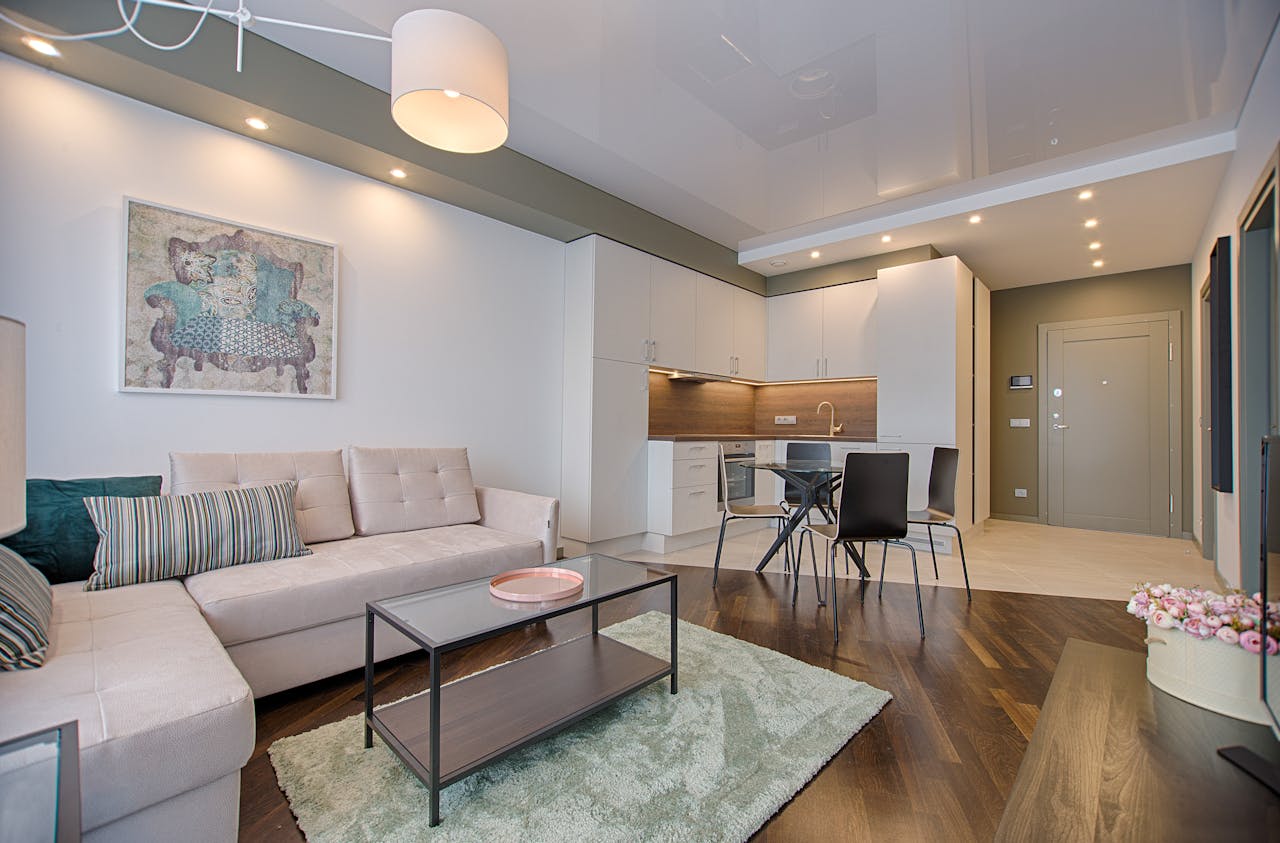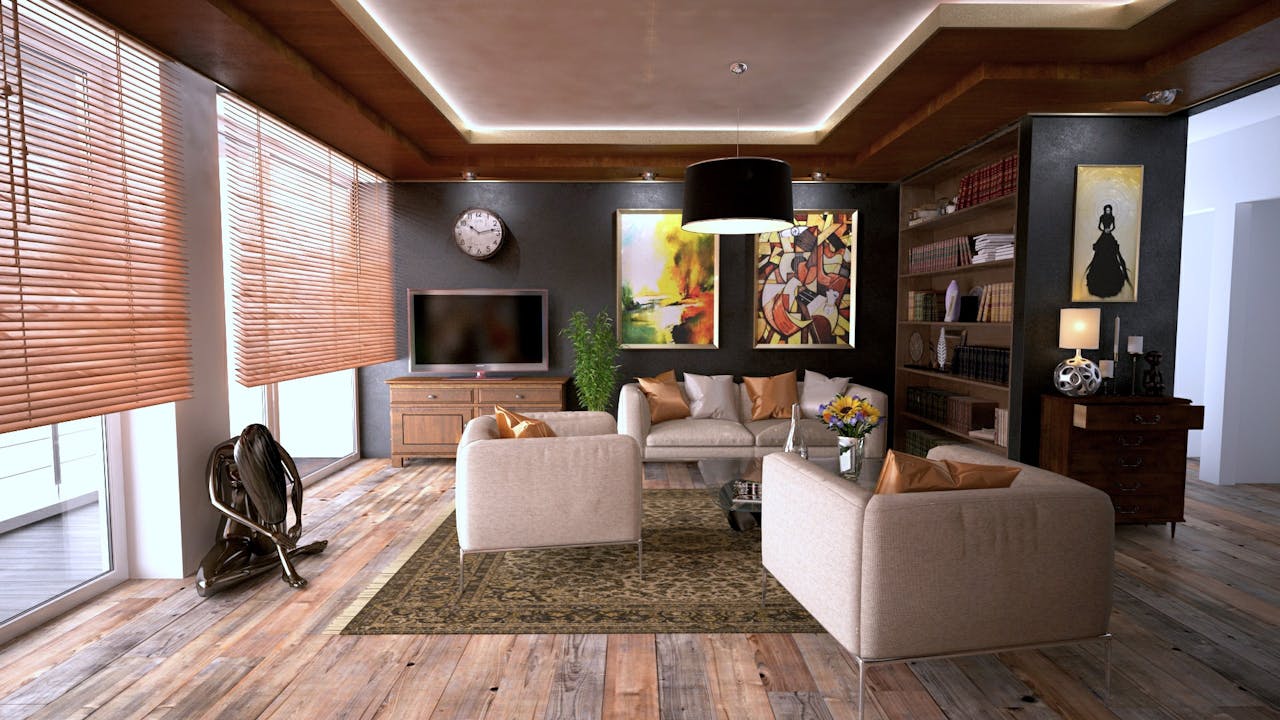Gothic architecture is known for its dramatic arches and vaults. It inspires moody and elegant spaces. Adding Gothic elements to your home decor brings mystery and luxury.
The Gothic interior style uses rich colors and intricate patterns. It’s great for adding drama to your home.
We’ll show you how to bring Gothic style into your home. We’ll talk about colors, furniture, lighting, and textiles. Embracing Gothic design makes your space elegant and mysterious.
Key Takeaways
- Understand the historical context of Gothic interior design
- Learn the key characteristics of the Gothic style
- Discover how to incorporate Gothic elements into your decor
- Explore color palettes, furniture, and textiles that fit the Gothic aesthetic
- Find out how to balance drama and elegance in your home
Understanding the Essence of Gothic Design
To truly appreciate Gothic interior design, we must first understand its historical context and the elements that define its unique aesthetic. It emerged in 12th century France. Gothic architecture is known for its pointed arches, ribbed vaults, and flying buttresses. These features not only provided structural support but also created a sense of grandeur and mystique.
Historical Context of Gothic Design
The term “Gothic” was initially used as an insult, labeling the style as barbaric. Yet, over four centuries, the Gothic style thrived across Europe. It evolved from architecture to influence various art forms and interior design. The historical context of Gothic design is crucial in understanding its essence, as it reflects the societal and cultural changes of the time.
Key Characteristics of Gothic Aesthetics
Gothic aesthetics are defined by a penchant for the dramatic, use of rich colors, and intricate patterns. These elements combine to create spaces that are both majestic and mysterious. The use of pointed arches and ribbed vaults continues to inspire interior designers today, who incorporate these features into furniture and decorative elements to evoke the grandeur of Gothic architecture.
The dramatic effect of Gothic design is further enhanced by the use of rich textiles and ornate patterns. These elements add depth and visual interest to a room, creating a cozy yet majestic atmosphere. By understanding and incorporating these key characteristics, homeowners can bring the essence of Gothic design into their living spaces.
Color Palette in Gothic Interiors
In Gothic home design, colors are key to a dramatic feel. The gothic color scheme uses deep, rich tones. These colors bring mystery and elegance to the space.
Dark and Rich Colors
The gothic color palette focuses on dark, rich hues for a moody, sophisticated vibe. Colors like burgundy, emerald green, and midnight blue are essential. They’re often paired with black to add depth and luxury.
- Burgundy adds a touch of opulence and warmth.
- Emerald green brings in a sense of luxury and drama.
- Midnight blue creates a calming yet mysterious atmosphere.
Accents and Contrast
Accents and contrast are crucial in Gothic interiors for visual interest. Metallic accents like gold and silver stand out against dark backgrounds. Jewel tones also add to the richness of the colors.
Mixing dark and light elements creates a balanced look. For example, dark walls with lighter furniture make a striking contrast. This adds to the overall aesthetic.
Choosing the right colors and accents is key to a sophisticated Gothic space. It’s all about finding the right balance between darkness and elegance.
Furniture Selection for Gothic Interiors
Gothic interiors need furniture that shows character and grandeur. Look for large, heavy pieces made from dark woods. The right furniture can make you feel like you’re in another time, full of mystery and drama.
Vintage and Antique Pieces
Vintage and antique furniture are key to Gothic design. Search for items with intricate carvings and ornate details. Dark woods like oak and walnut are perfect, adding depth and warmth.
- Ornate wooden chairs with carved Gothic motifs
- Heavy, dark wood tables with intricate leg work
- Antique armoires with detailed carvings and ornate hardware
When picking vintage or antique pieces, think about their condition, rarity, and how they fit the Gothic look. You might need to restore them to show their true beauty.
Modern Gothic Furniture Options
For a modern twist on Gothic, look at modern Gothic furniture. It mixes traditional elements with today’s design. These pieces have dramatic silhouettes and intricate details, honoring the Gothic style with modern materials.
- Find modern takes on classic Gothic designs, like furniture with pointed arches or quatrefoils.
- Choose pieces that mix traditional dark woods with modern materials like steel or glass.
- Go for furniture with bold, dramatic designs that show the grandeur of Gothic architecture.
By mixing vintage and modern, you can make a Gothic interior that’s both rich in history and modern in feel.
Lighting Choices in Gothic Design
Lighting is key in Gothic interior design. It creates a dramatic yet inviting atmosphere. We’ll see how different lights can make your home Gothic.
Ornate Lighting Fixtures
Chandeliers, wall sconces, and candelabras add a Gothic touch. They light up your space and decorate it. A grand chandelier can be a room’s centerpiece, with its detailed design and soft light.

Candelabras and wall sconces add depth to your lighting. They highlight architectural features and decorations, enhancing the Gothic theme.
Layering Light
Ambient and task lighting are essential for a balanced scheme. Ambient lighting sets the mood, while task lighting focuses on activity areas. Layering these lights creates a cozy, inviting space.
Here’s a table showing how different lights work in a Gothic room:
| Lighting Type | Function | Gothic Design Element |
|---|---|---|
| Ambient Lighting | Sets overall mood | Dramatic chandeliers |
| Task Lighting | Focuses on specific areas | Ornate wall sconces |
| Accent Lighting | Highlights decorative elements | Candelabras |
Experts say, “Layering light is crucial for a visually appealing space.” Mixing lighting types makes your Gothic design both beautiful and practical.
“The right lighting can make a room feel like a sanctuary or a spectacle. In Gothic design, it’s about creating an atmosphere that’s both mysterious and inviting.”
Choosing the right lights and layering them can turn your home Gothic. Whether you love chandeliers or candelabras, the right lighting makes your space reflect your style.
Textiles and Patterns in Gothic Decor
Gothic interiors use rich textiles and patterns to show luxury and mystery. Fabrics, upholstery, and patterns can change a space, making it feel more luxurious and immersive.
Fabrics and Upholstery
Heavy velvet drapes, elaborate lace, and intricate brocades are key in Gothic decor. These rich fabrics add texture and depth, making a room cozy and inviting. Think about the color palette and aesthetic you want.
For upholstery, pick fabrics that look good and are durable and comfy. Velvet is a favorite for its luxurious feel. Use patterned fabrics with Gothic motifs, like florals or geometric designs, to add depth to your furniture.
Patterns that Enhance Gothic Themes
Patterns are vital in Gothic home decor. Intricate florals, geometric motifs, and complex designs add visual interest and depth. Use these patterns in wallpaper, rugs, and throw pillows to create a cohesive atmosphere.
When mixing patterns, balance is crucial. Pair bold patterns with simpler designs to avoid overwhelming the space. For example, a bold, floral-patterned rug can work well with simpler, solid-colored furniture for a harmonious look.
Incorporating Artwork and Accessories
Artwork and accessories are key to a dark, mystical look in Gothic interiors. They add depth and create a unified style that fits the Gothic theme.
Gothic Art Styles
Gothic art is known for its dramatic and mysterious vibe. Using medieval-inspired paintings or prints can make your home feel more authentic. Look for artwork with mystical or medieval themes to enhance the dark home aesthetic.
Some popular Gothic art styles include:
- Medieval-inspired paintings
- Prints featuring mystical creatures
- Religious artwork with intricate details
Decorative Elements and Accessories
Decorative items and accessories are vital for a Gothic feel. Displaying antique books, for example, brings history and mystery to your space. Mystical or religious artifacts, along with ornate metalwork, add to the atmosphere.
Here are some decorative elements to consider:
| Element | Description |
|---|---|
| Antique Books | Adds a sense of history and mystery |
| Mystical Artifacts | Enhances the mystical ambiance |
| Ornate Metalwork | Contributes to the dramatic appeal |
When picking artwork and accessories, choose pieces that match the Gothic style. This way, you can create a space that truly captures the Gothic spirit.

Wall Treatments in Gothic Design
The right wall treatment can take your Gothic home interior design to new heights. Wall treatments are key to creating a Gothic ambiance. They set the tone for the entire space.
Wallpaper is a great way to achieve a dramatic Gothic look. Choose an elegant patterned paper in styles like flocked velvet, Damask, Jacquard, or Brocade. These textures and patterns add depth and interest to your walls. Flocked velvet wallpaper adds luxury, while Damask patterns bring historical elegance.
Wallpaper and Texturing Techniques
Wallpaper is perfect for making a statement without bold, dark walls. Look for designs that reflect Gothic architecture influences, like Gothic motifs or classic damask patterns. Texturing techniques, like embossing or textured paints, can also make your walls more appealing.
Dark Paint Colors and Finishes
Dark paint colors can create a cozy, mysterious atmosphere. Shades like deep reds, blacks, and dark greens work well. Metallic paint finishes or textured elements can enhance this effect.
When picking a dark paint color, think about your Gothic color scheme. Rich jewel tones add depth, while darker shades bring drama and luxury. Balance is key in Gothic design. Make sure your dark walls are balanced with lighter elements in the room.
Utilizing Architectural Features
Architectural features are key to Gothic interior design, bringing drama and grandeur. Elements like arches, vaults, and moldings help create a Gothic atmosphere at home.
Arches and Vaults
Arches and vaults are essential Gothic features, adding grandeur and history. Elegant archways can frame doorways, windows, or separate areas. Vaulted ceilings make rooms feel taller and airier, enhancing the Gothic look.
Adding ribbed vaults or pointed arches brings a touch of history to your space. These features add visual interest and connect your design to Gothic history.
Moldings for Gothic Appeal
Moldings are vital in Gothic design, adding detail and sophistication. Intricately carved moldings with Gothic motifs can adorn ceilings, walls, and furniture. They add depth and visual interest.
For a true Gothic feel, use moldings with floral patterns or acanthus leaf designs. These patterns recall traditional Gothic craftsmanship. By choosing and placing moldings wisely, you can boost your home’s Gothic look and create a unified space.
The Role of Nature in Gothic Interiors
Mixing natural elements with Gothic design creates a unique look. Gothic interiors are often dark and closed off. But adding nature brings a fascinating contrast.
Indoor Plants and Gothic Styles
Indoor plants can make your Gothic space more beautiful. Look for plants with dark or unusual leaves, like black calla lilies or dark-leaved alocasia. They add a natural touch and make the space feel mysterious.
- Choose plants with unique or dark foliage to complement Gothic decor.
- Use planters that reflect Gothic styles, such as those with intricate designs or dark finishes.
- Consider the symbolic meanings of plants; for example, ferns can symbolize sincerity and humility, adding a layer of depth to your decor.
Bringing the Outdoors In
You can also bring the outdoors into your Gothic space. Use natural materials or motifs. This could be reclaimed wood furniture, stone or brick elements, or botanical prints and natural textiles.
As interior design experts say, finding the right balance is key. Choose natural elements that match your Gothic decor. This way, your space will feel mysterious yet inviting.
“Nature has a way of softening the edges of even the most dramatic interior designs, making spaces feel more lived-in and welcoming.”
To find this balance, layer natural elements with your Gothic decor. For example, pair dark, ornate furniture with greenery or natural textiles. This contrast will make your space even more captivating.
Creating a Cozy Atmosphere
To make a Gothic-inspired home cozy, we need to layer textures and fabrics carefully. Gothic design is often seen as grand and dramatic. But, we also want our space to feel warm and inviting. We can achieve this by adding elements that bring warmth and depth to our decor.
Layering Textures and Fabrics
Layering different textures and fabrics is key to coziness. We can mix plush furniture with intricate patterns and soft lighting. For example, pair a velvet sofa with a patterned rug and throw blankets in dark colors.
The goal is to mix textures for a space that looks interesting and feels inviting.
- Velvet and lace for a luxurious feel
- Intricately patterned rugs to add depth
- Throw blankets in rich, dark colors for coziness
For more ideas on layering textures and fabrics, check out our guide on Gothic interior design.
Comfortable Seating Arrangements
Comfortable seating is crucial for a cozy Gothic-inspired home. Choose plush furniture that looks grand and feels comfortable. Oversized armchairs and sofas with soft cushions are perfect for relaxing.
By focusing on layering textures and fabrics and creating comfy seating, we can make our space cozy. This coziness complements the dramatic elements of Gothic design. It’s all about finding the right balance for a dark home aesthetic that feels welcoming.
Tips for Achieving Balance in Gothic Design
To make your gothic home interior design stand out, balance is key. The dark look of this style can feel too much if not balanced with lighter touches.
Balancing Dark Aesthetics
Adding metallic accents or natural textiles to your gothic decor can help. These elements bring warmth and sophistication, making your space feel unique and welcoming.
Mixing Gothic with Modern Elements
Combining gothic pieces with modern touches can also elevate your space. Pairing vintage or antique gothic furniture with modern accents creates a balanced look. This mix adds depth and interest to your gothic home.
With these tips, you can create a gothic home interior design that’s both balanced and captivating. It will reflect your personal style beautifully.



